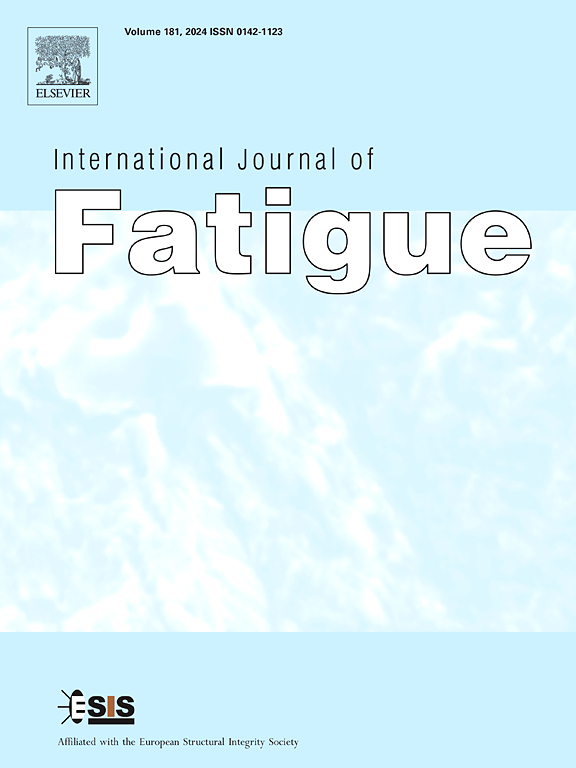Experimental analysis of static and fatigue performance of hybrid double-lap joints in thin primary metallic aircraft structures
IF 6.8
2区 材料科学
Q1 ENGINEERING, MECHANICAL
引用次数: 0
Abstract
This study investigates and compares the static and fatigue performance of double-lap joint repairs applied to primary thin aircraft structures assembled using traditional fastening, pure bonding, and hybrid methods. Baseline configurations, representing optimally assembled joints with inherent designed strength, were compared to configurations with simulated defects, designed to replicate practical flaws in the bond region that may remain undetected by current non-destructive inspection techniques. Specimens were subjected to static and fatigue tests under controlled loading conditions, with strain gauges and optical camera recordings to provide real-time monitoring of strain distribution and crack growth. Hybrid joints, combining adhesive bonding and mechanical fastening, exhibited superior strength and stiffness compared to mechanically fastened joints, and comparable performance to purely bonded joints under optimal conditions. In the studied defective scenarios, hybrid joints restored up to four times the strength of their purely bonded counterparts. Fatigue tests demonstrated that hybrid joints outperformed mechanically fastened joints, achieving twelve times the fatigue resistance and, exhibited a 10% improvement over purely bonded configurations when normalised to a common strain level. This advantage was particularly evident in scenarios involving undetectable bondline defects that may arise in practice, where hybrid joints effectively safeguarded purely bonded configurations from abrupt failures and significantly improved their fatigue resistance. Visual inspections and strain measurements further confirmed that the inclusion of rivets played a crucial role in suppressing Mode I opening and peeling stresses, thereby arresting crack growth and enhancing joint durability. These findings highlight the potential of hybrid joints to improve the durability and safety of thin aircraft structures, offering significant cost savings and enhanced operational availability. This study presents part of an assessment programme to certify bonded repairs on thin primary metallic aircraft structures.
薄型初级金属飞机结构混合双搭接静力与疲劳性能试验分析
本研究调查并比较了采用传统紧固、纯粘接和混合方法组装的轻型飞机结构的双搭接修复的静态和疲劳性能。基线配置代表了具有固有设计强度的最佳组装接头,并与具有模拟缺陷的配置进行了比较,模拟缺陷旨在复制当前无损检测技术无法检测到的键合区域的实际缺陷。试件在可控载荷条件下进行静力和疲劳试验,通过应变片和光学摄像机记录,实时监测应变分布和裂纹扩展情况。混合接头结合了粘合剂粘合和机械紧固,与机械紧固接头相比,具有更高的强度和刚度,在最佳条件下与纯粘合接头性能相当。在研究的缺陷情况下,混合接头恢复的强度是纯粘合接头的四倍。疲劳测试表明,混合接头的性能优于机械紧固接头,其抗疲劳性能是机械紧固接头的12倍,当归一化到普通应变水平时,其性能比纯粘合接头提高了10%。这一优势在实际应用中可能出现无法检测到的键合缺陷的情况下尤为明显,在这种情况下,混合接头有效地保护了纯键合结构免受突然失效的影响,并显著提高了其抗疲劳性。目视检查和应变测量进一步证实,铆钉在抑制I型打开和剥离应力方面发挥了至关重要的作用,从而阻止了裂纹的扩展,提高了接缝的耐久性。这些发现突出了混合接头在提高薄飞机结构的耐久性和安全性方面的潜力,提供了显著的成本节约和增强的操作可用性。本研究是鉴定薄初级金属飞机结构保税维修的评估方案的一部分。
本文章由计算机程序翻译,如有差异,请以英文原文为准。
求助全文
约1分钟内获得全文
求助全文
来源期刊

International Journal of Fatigue
工程技术-材料科学:综合
CiteScore
10.70
自引率
21.70%
发文量
619
审稿时长
58 days
期刊介绍:
Typical subjects discussed in International Journal of Fatigue address:
Novel fatigue testing and characterization methods (new kinds of fatigue tests, critical evaluation of existing methods, in situ measurement of fatigue degradation, non-contact field measurements)
Multiaxial fatigue and complex loading effects of materials and structures, exploring state-of-the-art concepts in degradation under cyclic loading
Fatigue in the very high cycle regime, including failure mode transitions from surface to subsurface, effects of surface treatment, processing, and loading conditions
Modeling (including degradation processes and related driving forces, multiscale/multi-resolution methods, computational hierarchical and concurrent methods for coupled component and material responses, novel methods for notch root analysis, fracture mechanics, damage mechanics, crack growth kinetics, life prediction and durability, and prediction of stochastic fatigue behavior reflecting microstructure and service conditions)
Models for early stages of fatigue crack formation and growth that explicitly consider microstructure and relevant materials science aspects
Understanding the influence or manufacturing and processing route on fatigue degradation, and embedding this understanding in more predictive schemes for mitigation and design against fatigue
Prognosis and damage state awareness (including sensors, monitoring, methodology, interactive control, accelerated methods, data interpretation)
Applications of technologies associated with fatigue and their implications for structural integrity and reliability. This includes issues related to design, operation and maintenance, i.e., life cycle engineering
Smart materials and structures that can sense and mitigate fatigue degradation
Fatigue of devices and structures at small scales, including effects of process route and surfaces/interfaces.
 求助内容:
求助内容: 应助结果提醒方式:
应助结果提醒方式:


